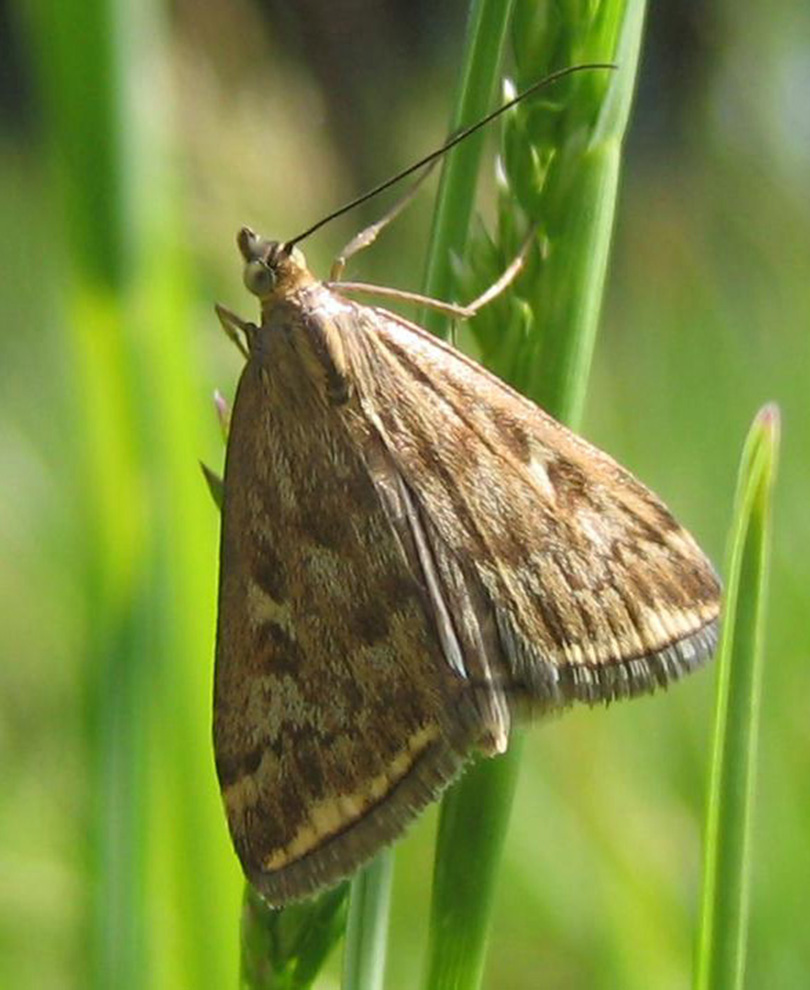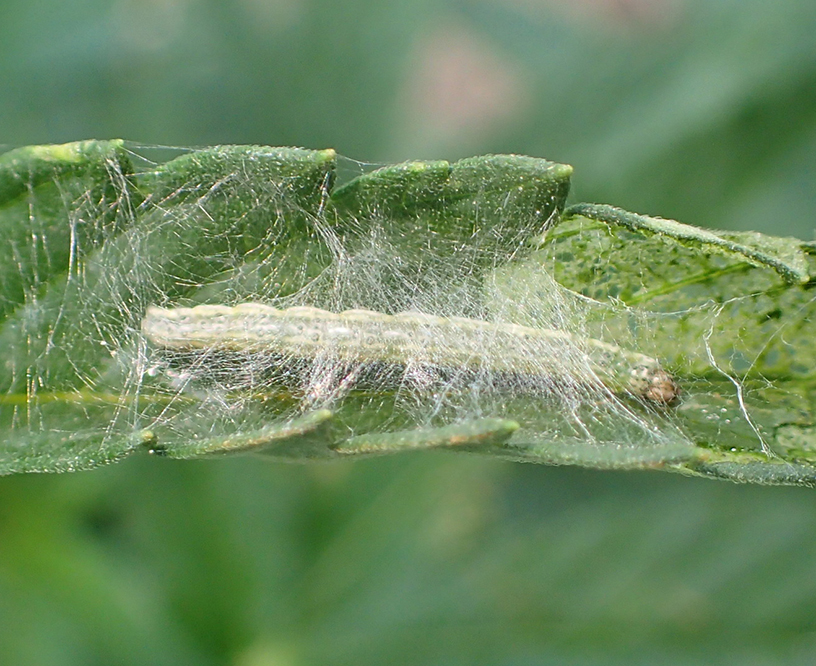Beet Webworm
Loxostege sticticalis





Hosts
- Beets
- Field-grown hemp
- Amaranthus
- Legumes
- Spinach
- Cotton
- Corn
- Eggplant
- Variety of weeds
Description
Larvae are primarily green with light stripes and white spots that contain black centers. Adults are brownish-tan moths that have white markings on their wings.
Life Cycle
Egg | Larva | Pupa | Adult- 2 generations per year.
- Overwinter as larvae in soil and pupate in late spring.
- Adults emerge in June and females lay egg clusters on the undersides of leaves.
- Larvae disperse and feed on leaves.
- Larvae drop to the ground to pupate in the soil.
Damage Symptoms
Larvae first feed on leaf surfaces, skeletonizing an area the size of its body. As larvae grow, they roll leaflets or pull leaves together with their silk and feed within a leaf tube. Feeding damage can also include irregular holes, visible webbing, and shredded leaves.
Time for Concern
Mid-summer to late fall.
When and Where to Scout
- Adults fly at night and are rarely seen.
- Look for small egg masses on the undersides of leaves starting in June.
- Larvae can be found beginning in June to early July.
Threat Level
Low. Foliage damage is minor and should not reduce yields.
Occurrence in Utah
Commonly found in field production feeding on random leaflets. Suspected damage to flower buds, but not confirmed.
Management
- Maintain natural enemies.
- Remove weeds and other plant debris surrounding crop.
- Hand-pick and destroy larvae.
- Approved insecticides are available. One option is Bacillus thuringiensis (Bt), which must be consumed, so it should only be used when caterpillars are less than one-half inch in size.
When to Consider Treatment
If chronic infestation has occurred, or if large population sizes are consistently present.
Look-alikes
Other caterpillars.
Caterpillar Insecticides
| Utah-Registered Product | Active Ingredient(s) | Notes |
|---|---|---|
| Agree WG | Bacillus thuringiensis ssp. aizawa | |
| Aza-Direct Biological Insecticide | azadirachtin | |
| AzaGuard | azadirachtin | |
| AzaSol | azadirachtin | |
| Azatin O Biological Insecticide | azadirachtin | |
| Azatrol EC Insecticide | azadirachtin | |
| Azera Insecticide | azadirachtin | |
| BT Now | Bacillus thuringiensis ssp. kurstaki | Greenhouse use only. |
| Bug Buster-O Extinguish Ant Bait | pyrethrins | Greenhouse use only. |
| Deadzone | diatomaceous earth | |
| Deliver Biological Insecticide | Bacillus thuringiensis ssp. kurstaki | |
| DiPel DF Biological Insecticide | Bacillus thuringiensis ssp. kurstaki | |
| DiPel DF Biological Insecticide Dry Flowable |
Bacillus thuringiensis ssp. kurstaki | |
| DiPel PRO DF Biological Insecticide | Bacillus thuringiensis ssp. kurstaki | |
| Evergreen Crop Protection EC 60-6 | pyrethrins | |
| Ferti-Lome Dipel Dust Biological Insecticide (RTU) | Bacillus thuringiensis ssp. kurstaki | |
| Ferti-lome Fruit Tree Spray | pyrethrins | |
| Grandevo CG;WDG | Chromobacterium sub strain PRAA4-1 cells | |
| Javelin WG Biological Insecticide | Bacillus thuringiensis ssp. kurstaki | |
| Leprotec | Bacillus thuringiensis ssp. kurstaki | |
| Molt-X | azadirachtin | |
| Neemix 4.5 Insect Growth Regulator | azadirachtin | |
| Prizefighter | ammonium nonanoate | |
| Pycana | pyrethrins | Greenhouse use only. |
| Pyganic Crop Protection EC 1.4 II; 5.0 II | pyrethrins | |
| SPEAR-LEP | gs-omega/kappahxtx-hv1a | Supression only; combine with a Bt product for greater efficacy. |
| Tersus Insecticide | pyrethrins | |
| Thuricide N/G | Bacillus thuringiensis ssp. kurstaki | |
| Valent Professional Products DiPel Pro DF Biological Insecticide Dry Flowable |
Bacillus thuringiensis ssp. kurstaki | |
| Venerate CG | Burkholderia sp. strain A396 | |
| XenTari Biological Insecticide Dry Flowable | Bacillus thuringiensis ssp. aizawai |
Photo Credits
- Larva/feeding damage - USU Extension IPM Program
- Webbing appearance - Whitney Cranshaw, Colorado State University, Bugwood.org
- Adult - Engeser, Wikipedia

